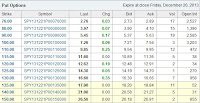Get an appropriate asset allocation and index. This is a key to controlling emotions in volatile markets. And we are in a volatile market environment.
Indexers can make this look robotic. Many have conquered the emotional side of investing. They are like the soldier running up Mt. Suribachi lobbing grenades as machine gun fire is raining down the side of the mountain. Are they superhuman investors? Don't they have emotions? How are indexers able to hang in and ride out the market turbulence?
The Secret
I'm here to let out the secret. Yes, we have emotions. Yes, we get nervous when we hear tornado sirens go off. Yes, our minds try to play tricks with us. We are, in fact, human.
DIY Investor looks at today's market and cringes. The media is playing up many disaster scenarios. Brush fires are all over the place. What happens if the unrest in the Middle East spills over to Saudi Arabia? In fact, it appears that the Saudis are the key to us getting out of this alive. If they don't push up oil production closer to capacity, oil prices will spike further, pushing U.S. gasoline prices sharply higher and killing off the nascent U.S.economic recovery. Revolutions are nasty.
DIY Investor looks at the Middle East power struggles and is fearful for the simple reason that the U.S. isn't in control. It reminds him of late season drives by the Washington Redskins, who could only get into the playoffs with an improbable chain of events--requiring other teams winning and losing particular games. You could only sit there and wring your hands once your fate was out of your hands.
Then there are the budget fights with public unions taking place in a number of states--another contagion type development that has the potential to spread.
Add to this that the budget limit is close to being broached and that our politicians at the national level care more about vote getting, posturing, and playing to the cameras than taking courageous action that benefits the country.
All of of this and much more weighs on the minds of indexers as it does most investors. What, then, prevents the indexers from pitching all the cargo and jumping overboard?
Controlling Emotions
First, indexers are probably a bit older than the average investor. In fact, I would like to see survey data on this, if anyone knows of some. It is hard not to get a sense of deja vu for those of a certain vintage. Secondly, indexers (even the younger ones) are knowledgeable about the history of markets. This is a real key. Take 9/11 as a fairly recent example. After the immediate horror sunk in, investors looked at markets and heard pundits proclaim people would never fly again. Expectations were rampant that further attacks would occur, and economic forecasters predicted disaster.
The S&P 500 hit a new peak six years later.
The recent example, of course, is the housing crisis of 2008. It looked as if the whole banking structure of the U.S. was going under. The potential for massive money market fund liquidations brought to mind the bank runs of the Great Depression. The bond rating agencies were exposed as incompetents and, to boot, it became unnervingly obvious that the top people at the Federal Reserve were clueless on the economic economic impact of the housing crisis. On March 9, 2009 the S&P 500 stood at 676.53; today it is at 1319.88.
Out of 26 investment management clients, I had 2 who totally "freaked out" (to use an up-to-date expression) and asked to put everything in money markets in early March 2009. They said that all the news was negative and they didn't see anything that could be positive for stocks. This, of course, is the best time to invest, as Buffett et al. have long argued.
The bottom line for indexers is that we have been through this before, we understand that emotions will be high, but, importantly we know that these situations offer opportunities. But, again, investors have to be allocated appropriately. It is important to understand the difference between the stage where an investor is accumulating assets and where assets are being drawn down. The investor building up the nest egg can confidently say that, from the perspective of several years down the road, this period will be seen as an opportunity to have added funds to the portfolio.
The bottom line is very simple. For most people, if they have an appropriate asset allocation and forget trying to time the market or pick stocks or even pick the sectors of the market that will provide the best performance, they will find they can control their emotions and be well positioned for calmer markets. Otherwise, IMHO, they shouldn't be in stocks at all. And that's OK.
 The important point here is to understand that these funds have large staffs of well-compensated analysts from the best business schools in the nation. What message does this send if they are indexing the bulk of their assets?
The important point here is to understand that these funds have large staffs of well-compensated analysts from the best business schools in the nation. What message does this send if they are indexing the bulk of their assets?








